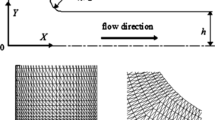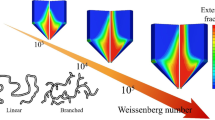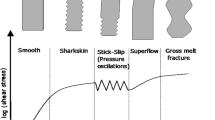Abstract
In this paper visualisation and direct velocity profile measurement experiments for a branched polypropylene melt in a 10:1 axisymmetric contraction demonstrate the onset of wall slip. Video processing of the flow shows the formation of vortices and their diminution with increasing flow rate. Numerical simulations using a multimode K-BKZ viscoelastic and a purely viscous (Cross) model—both of them incorporating a nonlinear slip law—were used to predict the flow kinematics and dynamics as well as to deduce the slip velocity function by performing fitting to the velocity profiles. It was found that the numerical predictions agree well with the experimental results for the velocity profiles, and vortex formation, growth and reduction. It is suggested that such experiments (visualisation of entrance flow and direct velocity profile measurement) can be useful in evaluating the validity of constitutive equations and slip laws in the flow of polymer melts through processing equipment.














Similar content being viewed by others
References
Archer LA, Larson RG, Chen YL (1995) Direct measurements of slip in sheared polymer solutions. J Fluid Mech 301:133–151
Binnington RJ, Troup GJ, Boger DV (1983) A low cost laser-speckle photographic technique for velocity measurement in slow flows. J Non-Newton Fluid Mech 12:255–267
Dealy JM, Wissbrun KF (1990) Melt rheology and its role in plastics processing—theory and applications. Van Nostrand Reinhold, New York
Galt J, Maxwell B (1964) Velocity profiles for polyethylene melts. Mod Plast (42):115–189
Gotsis AD (2002) Private communication to the authors, Universety of Delft
Hatzikiriakos SG, Dealy JM (1991) Wall slip of molten high density polyethylenes. I. Sliding plate rheometer studies. J Rheol 35:497–523
Kajiwara T, Barakos G, Mitsoulis E (1995) Rheological characterization of polymer solutions and melts with an integral constitutive equation. Int J Polym Anal Charact 1:201–215
Kazatchkov IB (1994) Melt fracture behaviour of molten polypropylenes. MASc Thesis, The University of British Columbia
Kazatchkov IB, Hatzikiriakos SG, Stewart CW (1995) Extrudate distortion in the capillary/slit extrusion of a molten polypropylene. Polym Eng Sci 35:1864–1871
Lim FJ, Schowalter WR (1989) Wall slip of narrow molecular weight distribution polybutadienes. J Rheol 33:1359–1382
Luo X-L, Mitsoulis E (1990) An efficient algorithm for strain history tracking in finite element computations of non-Newtonian fluids with integral constitutive equations. Int J Num Meth Fluids 11:1015–1031
Luo X-L, Tanner RI (1988) Finite element simulation of long and short circular die extrusion experiments using integral models. Int J Num Meth Eng 25:9–22
Migler KB, Hervet H, Leger L (1993) Slip transition of a polymer melt under shear stress. Phys Rev Lett 70:287–290
Mitsoulis E, Hatzikiriakos SG (2003) Bagley correction: the effect of contraction angle and its prediction. Rheol Acta 42:309–320
Mooney M (1931) Explicit formulas for slip and fluidity. J Rheol 2:210–222
Münstedt H, Schmidt M, Wassner E (2000) Stick and slip phenomena during extrusion of polyethylene melts as investigated by laser-Doppler velocimetry. J Rheol 44:413–427
Papanastasiou AC, Scriven LE, Macosco CW (1983) An integral constitutive equation for mixed flows: viscoelastic characterization. J Rheol 27:387–410
Ramamurthy AV (1986) Wall slip in viscous fluids and influence of materials of construction. J Rheol 30:337–357
Rosenbaum EE, Hatzikiriakos SG (1997) Wall slip in the capillary flow of molten polymers subject to viscous heating. AIChE J 43:598–608
Silliman WJ, Scriven LE (1980) Separating flow near a static contact line: slip at a wall and shape of a free surface. J Comp Phys 34:287–313
Tremblay B (1994) Visualization of the flow of low density polyethylene polystyrene blends through a planar step contraction. J Non-Newton Fluid Mech 52:323–331
Acknowledgements
Financial assistance from the Natural Sciences and Engineering Research Council (NSERC) of Canada and the General Secretariat for Research and Technology (GGET) of Greece are gratefully acknowledged. The authors are indebted to Prof. Alexander Gotsis of the University of Delft for providing rheological experimental data, especially on the elongational viscosity.
Author information
Authors and Affiliations
Corresponding author
Rights and permissions
About this article
Cite this article
Mitsoulis, E., Kazatchkov, I.B. & Hatzikiriakos, S.G. The effect of slip in the flow of a branched PP melt: experiments and simulations. Rheol Acta 44, 418–426 (2005). https://doi.org/10.1007/s00397-004-0423-2
Received:
Accepted:
Published:
Issue Date:
DOI: https://doi.org/10.1007/s00397-004-0423-2




